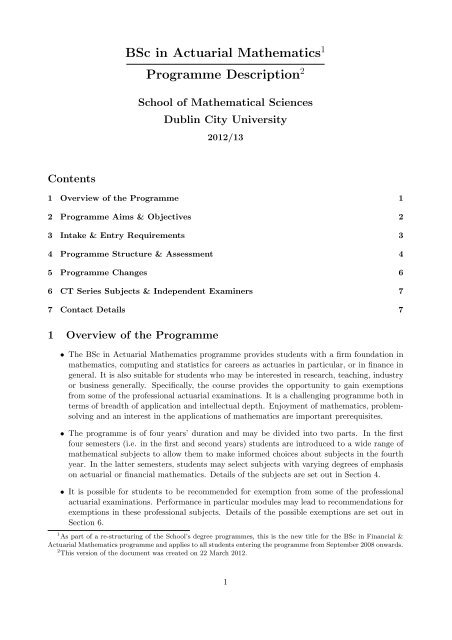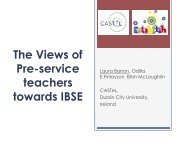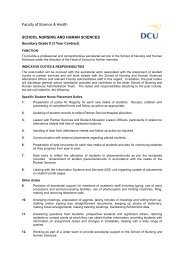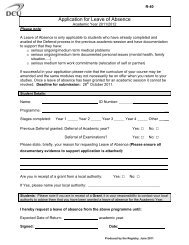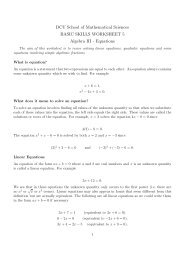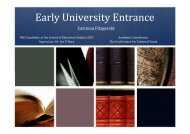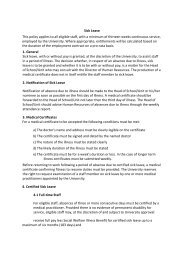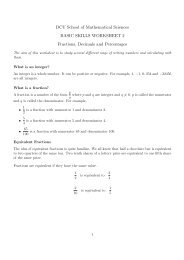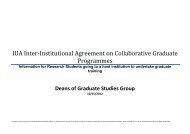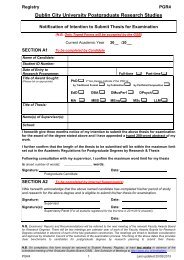BSc in Actuarial Mathematics1 Programme Description2 - DCU
BSc in Actuarial Mathematics1 Programme Description2 - DCU
BSc in Actuarial Mathematics1 Programme Description2 - DCU
- No tags were found...
You also want an ePaper? Increase the reach of your titles
YUMPU automatically turns print PDFs into web optimized ePapers that Google loves.
<strong>BSc</strong> <strong>in</strong> <strong>Actuarial</strong> Mathematics 1<strong>Programme</strong> Description 2School of Mathematical SciencesDubl<strong>in</strong> City University2012/13Contents1 Overview of the <strong>Programme</strong> 12 <strong>Programme</strong> Aims & Objectives 23 Intake & Entry Requirements 34 <strong>Programme</strong> Structure & Assessment 45 <strong>Programme</strong> Changes 66 CT Series Subjects & Independent Exam<strong>in</strong>ers 77 Contact Details 71 Overview of the <strong>Programme</strong>• The <strong>BSc</strong> <strong>in</strong> <strong>Actuarial</strong> Mathematics programme provides students with a firm foundation <strong>in</strong>mathematics, comput<strong>in</strong>g and statistics for careers as actuaries <strong>in</strong> particular, or <strong>in</strong> f<strong>in</strong>ance <strong>in</strong>general. It is also suitable for students who may be <strong>in</strong>terested <strong>in</strong> research, teach<strong>in</strong>g, <strong>in</strong>dustryor bus<strong>in</strong>ess generally. Specifically, the course provides the opportunity to ga<strong>in</strong> exemptionsfrom some of the professional actuarial exam<strong>in</strong>ations. It is a challeng<strong>in</strong>g programme both <strong>in</strong>terms of breadth of application and <strong>in</strong>tellectual depth. Enjoyment of mathematics, problemsolv<strong>in</strong>gand an <strong>in</strong>terest <strong>in</strong> the applications of mathematics are important prerequisites.• The programme is of four years’ duration and may be divided <strong>in</strong>to two parts. In the firstfour semesters (i.e. <strong>in</strong> the first and second years) students are <strong>in</strong>troduced to a wide range ofmathematical subjects to allow them to make <strong>in</strong>formed choices about subjects <strong>in</strong> the fourthyear. In the latter semesters, students may select subjects with vary<strong>in</strong>g degrees of emphasison actuarial or f<strong>in</strong>ancial mathematics. Details of the subjects are set out <strong>in</strong> Section 4.• It is possible for students to be recommended for exemption from some of the professionalactuarial exam<strong>in</strong>ations. Performance <strong>in</strong> particular modules may lead to recommendations forexemptions <strong>in</strong> these professional subjects. Details of the possible exemptions are set out <strong>in</strong>Section 6.1 As part of a re-structur<strong>in</strong>g of the School’s degree programmes, this is the new title for the <strong>BSc</strong> <strong>in</strong> F<strong>in</strong>ancial &<strong>Actuarial</strong> Mathematics programme and applies to all students enter<strong>in</strong>g the programme from September 2008 onwards.2 This version of the document was created on 22 March 2012.1
• Information Technology:– The full-year, first-year Comput<strong>in</strong>g module was dedicated to C++ programm<strong>in</strong>g from2008/09 to 2011/12 <strong>in</strong>clusive, after which time the programm<strong>in</strong>g language will be Matlab(the second-year Numerical Mathematics module, <strong>in</strong> which 25% is allocated to comput<strong>in</strong>gassignments, will switch to Matlab from 2013/14 onwards).– The Treasury Mathematics module will be entirely Excel-based, and will <strong>in</strong>volve studentsus<strong>in</strong>g real market data and Excel to price vanilla treasury products (futures, swaps,FRA’s etc) along with other <strong>in</strong>terest rate products. The techniques <strong>in</strong>clude those covered<strong>in</strong> CT1 and other techniques not currently <strong>in</strong> the actuarial syllabus.– The Statistics modules employ various computer packages. Furthermore, <strong>in</strong>formationtechnology will be used <strong>in</strong> the delivery of many modules <strong>in</strong> the form of ’moodle’ pages,and it is anticipated that the Industrial placement <strong>in</strong> third year will <strong>in</strong>volve programm<strong>in</strong>gor the use of computer packages for most students.• Communication Skills:The Industrial Placement <strong>in</strong> third year will have a large and practical communication element.• Resource Management Skills:The modules Introduction to Economics and Mathematics of F<strong>in</strong>ance are delivered dur<strong>in</strong>gthe first two years of the degree. These courses will <strong>in</strong>crease economic awareness and willhelp the students to make more <strong>in</strong>formed f<strong>in</strong>ancial decisions <strong>in</strong> both bus<strong>in</strong>ess and personalsett<strong>in</strong>gs.• Learn<strong>in</strong>g Skills:University-level mathematics requires a different learn<strong>in</strong>g method than pre-university mathematics.Part of the difficulty encountered by students <strong>in</strong> mathematics programmes is mak<strong>in</strong>gthis transition. The first year module ’Maths Experience’ will address the issue of <strong>in</strong>dependentlearn<strong>in</strong>g to assist students <strong>in</strong> mak<strong>in</strong>g this transition, while the modules Analysis I andDifferential Equations <strong>in</strong> second year will address the change to abstract th<strong>in</strong>k<strong>in</strong>g, us<strong>in</strong>g themethod of guided enquiry.3 Intake & Entry Requirements• The programme can be accessed exclusively through the Central Applications Office (CAOcode DC126). The entry requirement (<strong>in</strong> addition to the general conditions set by the University)is a grade B3 or higher <strong>in</strong> honours Mathematics <strong>in</strong> the Irish Leav<strong>in</strong>g Certificateexam<strong>in</strong>ation. Where a school-leav<strong>in</strong>g exam<strong>in</strong>ation other than the Leav<strong>in</strong>g Certificate is presented,an equivalent grade <strong>in</strong> Mathematics will be required.• There is also an alternative entry mechanism via the common entry route, which has a designatedCAO code (DC127) and is entitled the Common Entry <strong>in</strong>to <strong>Actuarial</strong>, F<strong>in</strong>ancial andMathematical Sciences (CAFM). The entry requirement (<strong>in</strong> addition to the general conditionsset by the university) is also a grade B3 or higher <strong>in</strong> honours Mathematics <strong>in</strong> the IrishLeav<strong>in</strong>g Certificate exam<strong>in</strong>ation, <strong>in</strong> l<strong>in</strong>e with the standard required for direct entry <strong>in</strong>to the<strong>BSc</strong> <strong>in</strong> <strong>Actuarial</strong> Mathematics programme.• The entry requirement equates to a score of at least 75% on the average of two exam<strong>in</strong>ationpapers <strong>in</strong> Leav<strong>in</strong>g Certificate Mathematics. Where a school-leav<strong>in</strong>g exam<strong>in</strong>ation other thanthe Leav<strong>in</strong>g Certificate is presented, an equivalent grade <strong>in</strong> Mathematics will be required.3
• At the end of the second year, students on the common entry degree will be ranked basedon their second-year results. In order of merit, students will then choose places on the <strong>BSc</strong><strong>in</strong> <strong>Actuarial</strong> Mathematics or the <strong>BSc</strong> <strong>in</strong> F<strong>in</strong>ancial Mathematics or the <strong>BSc</strong> <strong>in</strong> ApplicableMathematics. At any particular stage, a maximum of 50 students per year on either degreewill be permitted. Admission to the <strong>BSc</strong> <strong>in</strong> <strong>Actuarial</strong> Mathematics will also be subject tothe approval of the Progression & Awards Board, <strong>in</strong> consultation with the External andIndependent Exam<strong>in</strong>ers for that degree.4 <strong>Programme</strong> Structure & Assessment• The modules which make up the programme are core or option modules <strong>in</strong> semesters 1 and2, or year-long l<strong>in</strong>ked modules, core or option. Each module carries the credit value givenbelow. Successful completion of each year of the programme has an ECTS credit value of 60.• With<strong>in</strong> the Bologna Declaration, it is proposed that European Higher Education should bebased on courses which are compatible with the European Credit Transfer System (ECTS).ECTS is a tool for conversion between national education systems and is an important <strong>in</strong>strument<strong>in</strong> remov<strong>in</strong>g barriers to mobility. The two ma<strong>in</strong> elements of ECTS are a credit systemand a grad<strong>in</strong>g scale. In the ECTS credit system, one year of full-time study corresponds to60 credits. ECTS also offers a grad<strong>in</strong>g scale which can be used to convert grades awarded <strong>in</strong>one national system <strong>in</strong>to the most closely-correspond<strong>in</strong>g grade <strong>in</strong> another system. The twoelements, when used together, enable a student’s learn<strong>in</strong>g achievement <strong>in</strong> one <strong>in</strong>stitution tobe recognised by another.• The distribution of modules across the programme years is presented <strong>in</strong> Table 1. The follow<strong>in</strong>gpo<strong>in</strong>ts should be noted:– Year 1: Modules 1, 2 and 3 are core <strong>in</strong> Semester 1, modules 4, 5 and 6 are core <strong>in</strong>Semester 2, and modules 7 and 8 are year-long core modules.– Year 2: Modules 9 to 13 are core <strong>in</strong> Semester 1 and modules 14 to 19 are core <strong>in</strong> Semester2.– Year 3: Modules 20 to 23 are core and module 24 is optional <strong>in</strong> Semester 1. Studentsundertake a 32-week <strong>in</strong>dustrial placement (INTRA) commenc<strong>in</strong>g at the beg<strong>in</strong>n<strong>in</strong>g ofSemester 2.– Year 4: Modules 26 to 29 are core <strong>in</strong> Semester 1. Modules 30 and 31 are core <strong>in</strong> Semester2 and students must choose two of the Semester 2 option modules 32 to 35.• The core idea underp<strong>in</strong>n<strong>in</strong>g the learn<strong>in</strong>g philosophy of this degree is that graduates <strong>in</strong> appliedmathematics must accumulate a comb<strong>in</strong>ation of knowledge, skills and modes of th<strong>in</strong>k<strong>in</strong>g <strong>in</strong>order to succeed <strong>in</strong> br<strong>in</strong>g<strong>in</strong>g their education to bear <strong>in</strong> their future careers. We see thisaccumulation as happen<strong>in</strong>g on a gradual basis, with students start<strong>in</strong>g at a level where theymust review and ref<strong>in</strong>e their school-mathematics knowledge and skills and beg<strong>in</strong> the processof reflect<strong>in</strong>g on the nature of mathematics and their engagement with it.• In subsequent years, students will become more <strong>in</strong>dependent <strong>in</strong> their learn<strong>in</strong>g: modules deal<strong>in</strong>gspecifically with help<strong>in</strong>g students to make this transition take place <strong>in</strong> years one and two.In particular, the flow of modules is designed with a view to help<strong>in</strong>g student to make thetransition to the stage where they can construct their own formal mathematical arguments.4
ACM 2012/13Term<strong>in</strong>al Cont<strong>in</strong>uousNo. Code Module Title Credits Exam<strong>in</strong>ation AssessmentYear 11 MS103 L<strong>in</strong>ear Mathematics 1 5 80% 20%2 MS105 Calculus 7.5 75% 25%3 MS108 The Mathematical Experience 5 50% 50%4 MS104 L<strong>in</strong>ear Mathematics 2 5 80% 20%5 MS109 Analysis I 7.5 85% 15%6 MS117 Probability I 5 75% 25%7 CA167 Comput<strong>in</strong>g for Mathematics 15 70% 30%8 EF110 Introduction to Economics 10 70% 30%Year 29 MS205 Calculus of Several Variables 5 75% 25%10 MS213 Numerical Methods 7.5 75% 25%11 MS217 L<strong>in</strong>ear Algebra 5 75% 25%12 MS229 Analysis II 5 75% 25%13 MS255 Statistics 1 5 80% 20%14 AC316 Account<strong>in</strong>g 1 7.5 80% 20%15 MS206 Complex Analysis 5 75% 25%16 MS208 Probability II 5 75% 25%17 MS211 Differential Equations 5 75% 25%18 MS216 Mathematics of F<strong>in</strong>ance 5 80% 20%19 MS258 Statistics 2 5 80% 20%Year 320 EF316 Account<strong>in</strong>g 2 7.5 80% 20%21 MS308 Stochastic Modell<strong>in</strong>g 7.5 75% 25%22 MS318 F<strong>in</strong>ancial Mathematics 7.5 75% 25%23 MS332 <strong>Actuarial</strong> Modell<strong>in</strong>g 7.5 80% 20%24 MS306 Treasury Mathematics — P/F25 IN306 INTRA 30 100%Year 426 MS427 F<strong>in</strong>ancial Economics I 7.5 75% 25%27 MS447 Time Series 7.5 75% 25%28 MS449 Risk Theory 10 80% 20%29 MS450 Simulation for F<strong>in</strong>ance 7.5 100%30 MS428 F<strong>in</strong>ancial Economics II 7.5 75% 25%31 MS448 Life Cont<strong>in</strong>gencies 10 75% 25%32 EF520 F<strong>in</strong>ancial Eng<strong>in</strong>eer<strong>in</strong>g 7.5 75% 25%33 MS415 Optimization 7.5 75% 25%34 MS505 Cod<strong>in</strong>g & Cryptography 7.5 75% 25%35 MS551 Monte Carlo Methods <strong>in</strong> F<strong>in</strong>ance 7.5 50% 50%Table 1: 2012/13 Modules by ACM <strong>Programme</strong> Year5
• The guid<strong>in</strong>g philosophy beh<strong>in</strong>d the assessments is to develop and test the understand<strong>in</strong>g andmastery of the various skills required of a graduate <strong>in</strong> applied mathematics. The assessmentmethods will aim towards the measurement of specific module learn<strong>in</strong>g outcomes and theencouragement of creativity, critical th<strong>in</strong>k<strong>in</strong>g and academic writ<strong>in</strong>g skills.• The assessment of the modules will be by cont<strong>in</strong>uous assessment, project work and term<strong>in</strong>alexam<strong>in</strong>ation or by a comb<strong>in</strong>ation of these elements. The nature of the assessment and percentagemarks allocated to the elements of cont<strong>in</strong>uous assessment will vary depend<strong>in</strong>g on themodule. Table 1 <strong>in</strong>dicates the relative breakdown of marks between cont<strong>in</strong>uous assessment(CA) and term<strong>in</strong>al exam<strong>in</strong>ation (TE) for each module.• Strict adherence to the University’s Marks and Standards will be observed <strong>in</strong> all mattersrelat<strong>in</strong>g to progression regulations, compensation regulations, accumulation of credits, theatta<strong>in</strong>ment levels for award classifications and regulations regard<strong>in</strong>g repeat attempts. All thetaught modules <strong>in</strong> the programme are eligible for compensation as def<strong>in</strong>ed <strong>in</strong> the Marks andStandards.• A brief summary of the ma<strong>in</strong> progression regulations and award classifications is given below:– The pass mark is 40%.– In order to progress from one year of study to the next, students must pass all modules,either unequivocally or by means of compensation (<strong>in</strong> accordance with such regulationsas are <strong>in</strong> place prescribed for the programme of study).– Classification of the f<strong>in</strong>al degree award will be based on the f<strong>in</strong>al-year modules:First-Class Honours 70%—100%Second-Class Honours, Grade 1 60%—69%Second-Class Honours, Grade 2 50%—59%Third-Class Honours 40%—49%– A student who fails a module or who does not take a full set of exam<strong>in</strong>ations <strong>in</strong> the f<strong>in</strong>alyear of the programme, is normally eligible for third-class honours only.5 <strong>Programme</strong> Changes• Year 4 of the ACM programme became available for the first time <strong>in</strong> 2011/12. While therewas no change to the orig<strong>in</strong>ally-accredited programme <strong>in</strong> terns of CT-associated modules,some new core and option modules have been added. The full set of module specificationsfor Year 4 were approved by the Institute of Actuaries Accreditation Panel, the IndependentExam<strong>in</strong>er and the External Exam<strong>in</strong>er.• From February 2011, the School of Mathematical Sciences assumed responsibility for theteach<strong>in</strong>g of CT3-associated modules CA255 and CA258. With some re-distribution of theCT3 learn<strong>in</strong>g objectives across modules, the module codes were amended to MS255 andMS258 respectively.• On a phased basis (see Tables 2, 3, 4 and 5), the orig<strong>in</strong>al CT2-associated modules of EF107Aand AC334 are be<strong>in</strong>g replaced by AC316 and EF316 (the latter two were the CT-associatedmodules <strong>in</strong> the old F<strong>in</strong>ancial & <strong>Actuarial</strong> Mathematics programme). While all the CT3learn<strong>in</strong>g objectives rema<strong>in</strong> <strong>in</strong> place, there will be some necessary re-organization of materialacross modules. ACM2 students have taken AC316 for the first time <strong>in</strong> 2011/12. EF316 willbe taken by ACM3 students for the first time <strong>in</strong> 2012/13.6
6 CT Series Subjects & Independent Exam<strong>in</strong>ersCT Series Subject <strong>DCU</strong> Modules Independent Exam<strong>in</strong>erCT1 F<strong>in</strong>ancial Mathematics MS318 John MillettCT2 F<strong>in</strong>ance & F<strong>in</strong>ancial Report<strong>in</strong>g AC316, EF316 John MillettCT3 Probability & Mathematical Statistics MS117, MS255, MS258 Peter SavillCT4 Models MS308, MS332 Peter SavillCT5 Cont<strong>in</strong>gencies MS448 Peter SavillCT6 Statistical Methods MS447, MS449 Peter SavillCT7 Economics EF110 John MillettCT8 F<strong>in</strong>ancial Economics MS427, MS428 John Millett7 Contact Details<strong>Programme</strong> Coord<strong>in</strong>ator:CT Series Exemptions Co-Ord<strong>in</strong>ator:<strong>Actuarial</strong> Adm<strong>in</strong>istrator:Dr Niamh O’SullivanNiamh.OSullivan@dcu.ieTel: +353 1 700 8219Room X135Prof John CarrollJohn.Carroll@dcu.ieTel: +353 1 700 8917Room X132Mr Ciarán McKennaCiaran.McKenna@dcu.ieTel: +353 1 700 7925Room HG017
Year 1ACM 2009/10Term<strong>in</strong>al Cont<strong>in</strong>uousNo. Code Module Title Credits Exam<strong>in</strong>ation Assessment1 MS105 Calculus 10 75% 25%2 MS108 The Mathematical Experience 2.5 50% 50%3 EF107A Corporate F<strong>in</strong>ance 7.5 75% 25%4 MS117 Probability I 5 75% 25%5 CA167 Comput<strong>in</strong>g for Mathematics 15 70% 30%6 EF110 Introduction to Economics 10 80% 20%7 MS106 L<strong>in</strong>ear Mathematics 10 75% 25%Year 28 CA255 Statistics I 5 100%9 MS205 Calculus of Several Variables 5 75% 25%10 MS209 Analysis I 7.5 60% 40%11 MS213 Numerical Methods 7.5 75% 25%12 MS217 L<strong>in</strong>ear Algebra 5 75% 25%13 CA258 Statistics II 5 80% 20%14 MS206 Complex Analysis 5 75% 25%15 MS208 Probability II 5 75% 25%16 MS211 Differential Equations 5 75% 25%17 MS216 Mathematics of F<strong>in</strong>ance 5 80% 20%18 MS229 Analysis II 5 75% 25%Year 3 (operational from 2010/11)19 AC334 Pr<strong>in</strong>ciples of Account<strong>in</strong>g & Taxation 10 80% 20%20 MS308 Stochastic Modell<strong>in</strong>g 7.5 75% 25%21 MS318 F<strong>in</strong>ancial Mathematics 7.5 75% 25%22 MS332 <strong>Actuarial</strong> Modell<strong>in</strong>g 7.5 100%23 MS306 Treasury Mathematics — P/F24 IN306 INTRA 30 100%Year 4 (operational from 2011/12)25 MS427 F<strong>in</strong>ancial Economics I 7.5 75% 25%26 MS447 Time Series 7.5 75% 25%27 MS449 Risk Theory 10 100%28 MS450 Simulation for F<strong>in</strong>ance 7.5 100%29 MS428 F<strong>in</strong>ancial Economics II 7.5 75% 25%30 MS448 Life Cont<strong>in</strong>gencies 10 75% 25%31 EF520 F<strong>in</strong>ancial Eng<strong>in</strong>eer<strong>in</strong>g 7.5 100%32 MS415 Optimization 7.5 75% 25%33 MS505 Cod<strong>in</strong>g & Cryptography 7.5 75% 25%34 MS551 Monte Carlo Methods <strong>in</strong> F<strong>in</strong>ance 7.5 50% 50%Table 2: 2009/10 Modules by ACM <strong>Programme</strong> Year8
ACM 2010/11Term<strong>in</strong>al Cont<strong>in</strong>uousNo. Code Module Title Credits Exam<strong>in</strong>ation AssessmentYear 11 MS105 Calculus 7.5 75% 25%2 MS108 The Mathematical Experience 5 50% 50%3 MS109 Analysis I 7.5 60% 40%4 MS117 Probability I 5 75% 25%5 CA167 Comput<strong>in</strong>g for Mathematics 15 70% 30%6 EF110 Introduction to Economics 10 80% 20%7 MS106 L<strong>in</strong>ear Mathematics 10 75% 25%Year 28 CA255 Statistics I 5 100%9 MS205 Calculus of Several Variables 5 75% 25%10 MS209 Analysis I 7.5 60% 40%11 MS213 Numerical Methods 7.5 75% 25%12 MS217 L<strong>in</strong>ear Algebra 5 75% 25%13 CA258 Statistics II 5 80% 20%14 MS206 Complex Analysis 5 75% 25%15 MS208 Probability II 5 75% 25%16 MS211 Differential Equations 5 75% 25%17 MS216 Mathematics of F<strong>in</strong>ance 5 80% 20%18 MS229 Analysis II 5 75% 25%Year 319 AC334 Pr<strong>in</strong>ciples of Account<strong>in</strong>g & Taxation 10 80% 20%20 MS308 Stochastic Modell<strong>in</strong>g 7.5 75% 25%21 MS318 F<strong>in</strong>ancial Mathematics 7.5 75% 25%22 MS332 <strong>Actuarial</strong> Modell<strong>in</strong>g 7.5 100%23 MS306 Treasury Mathematics — P/F24 IN306 INTRA 30 100%Year 4 (operational from 2011/12)25 MS427 F<strong>in</strong>ancial Economics I 7.5 75% 25%26 MS447 Time Series 7.5 75% 25%27 MS449 Risk Theory 10 100%28 MS450 Simulation for F<strong>in</strong>ance 7.5 100%29 MS428 F<strong>in</strong>ancial Economics II 7.5 75% 25%30 MS448 Life Cont<strong>in</strong>gencies 10 75% 25%31 EF520 F<strong>in</strong>ancial Eng<strong>in</strong>eer<strong>in</strong>g 7.5 100%32 MS415 Optimization 7.5 75% 25%33 MS505 Cod<strong>in</strong>g & Cryptography 7.5 75% 25%34 MS551 Monte Carlo Methods <strong>in</strong> F<strong>in</strong>ance 7.5 50% 50%Table 3: 2010/11 Modules by ACM <strong>Programme</strong> Year9
ACM 2011/12Term<strong>in</strong>al Cont<strong>in</strong>uousNo. Code Module Title Credits Exam<strong>in</strong>ation AssessmentYear 11 MS105 Calculus 7.5 75% 25%2 MS108 The Mathematical Experience 5 50% 50%3 MS109 Analysis I 7.5 60% 40%4 MS117 Probability I 5 75% 25%5 CA167 Comput<strong>in</strong>g for Mathematics 15 70% 30%6 EF110 Introduction to Economics 10 70% 30%7 MS106 L<strong>in</strong>ear Mathematics 10 80% 20%Year 28 MS205 Calculus of Several Variables 5 75% 25%9 MS213 Numerical Methods 7.5 75% 25%10 MS217 L<strong>in</strong>ear Algebra 5 75% 25%11 MS229 Analysis II 5 75% 25%12 MS255 Statistics I 5 80% 20%13 AC316 Account<strong>in</strong>g I 7.5 80% 20%14 MS206 Complex Analysis 5 75% 25%15 MS208 Probability II 5 75% 25%16 MS211 Differential Equations 5 75% 25%17 MS216 Mathematics of F<strong>in</strong>ance 5 80% 20%18 MS258 Statistics II 5 80% 20%Year 319 AC334 Pr<strong>in</strong>ciples of Account<strong>in</strong>g & Taxation 10 80% 20%20 MS308 Stochastic Modell<strong>in</strong>g 7.5 75% 25%21 MS318 F<strong>in</strong>ancial Mathematics 7.5 75% 25%22 MS332 <strong>Actuarial</strong> Modell<strong>in</strong>g 7.5 100%23 MS306 Treasury Mathematics — P/F24 IN306 INTRA 30 100%Year 425 MS427 F<strong>in</strong>ancial Economics I 7.5 75% 25%26 MS447 Time Series 7.5 75% 25%27 MS449 Risk Theory 10 100%28 MS450 Simulation for F<strong>in</strong>ance 7.5 100%29 MS428 F<strong>in</strong>ancial Economics II 7.5 75% 25%30 MS448 Life Cont<strong>in</strong>gencies 10 75% 25%31 EF520 F<strong>in</strong>ancial Eng<strong>in</strong>eer<strong>in</strong>g 7.5 75% 25%32 MS415 Optimization 7.5 75% 25%33 MS505 Cod<strong>in</strong>g & Cryptography 7.5 75% 25%34 MS551 Monte Carlo Methods <strong>in</strong> F<strong>in</strong>ance 7.5 50% 50%Table 4: 2011/12 Modules by ACM <strong>Programme</strong> Year10
ACM 2012/13Term<strong>in</strong>al Cont<strong>in</strong>uousNo. Code Module Title Credits Exam<strong>in</strong>ation AssessmentYear 11 MS103 L<strong>in</strong>ear Mathematics 1 5 80% 20%2 MS105 Calculus 7.5 75% 25%3 MS108 The Mathematical Experience 5 50% 50%4 MS104 L<strong>in</strong>ear Mathematics 2 5 80% 20%5 MS109 Analysis I 7.5 85% 15%6 MS117 Probability I 5 75% 25%7 CA167 Comput<strong>in</strong>g for Mathematics 15 70% 30%8 EF110 Introduction to Economics 10 70% 30%Year 29 MS205 Calculus of Several Variables 5 75% 25%10 MS213 Numerical Methods 7.5 75% 25%11 MS217 L<strong>in</strong>ear Algebra 5 75% 25%12 MS229 Analysis II 5 75% 25%13 MS255 Statistics 1 5 80% 20%14 AC316 Account<strong>in</strong>g 1 7.5 80% 20%15 MS206 Complex Analysis 5 75% 25%16 MS208 Probability II 5 75% 25%17 MS211 Differential Equations 5 75% 25%18 MS216 Mathematics of F<strong>in</strong>ance 5 80% 20%19 MS258 Statistics 2 5 80% 20%Year 320 EF316 Account<strong>in</strong>g 2 7.5 80% 20%21 MS308 Stochastic Modell<strong>in</strong>g 7.5 75% 25%22 MS318 F<strong>in</strong>ancial Mathematics 7.5 75% 25%23 MS332 <strong>Actuarial</strong> Modell<strong>in</strong>g 7.5 80% 20%24 MS306 Treasury Mathematics — P/F25 IN306 INTRA 30 100%Year 426 MS427 F<strong>in</strong>ancial Economics I 7.5 75% 25%27 MS447 Time Series 7.5 75% 25%28 MS449 Risk Theory 10 80% 20%29 MS450 Simulation for F<strong>in</strong>ance 7.5 100%30 MS428 F<strong>in</strong>ancial Economics II 7.5 75% 25%31 MS448 Life Cont<strong>in</strong>gencies 10 75% 25%32 EF520 F<strong>in</strong>ancial Eng<strong>in</strong>eer<strong>in</strong>g 7.5 75% 25%33 MS415 Optimization 7.5 75% 25%34 MS505 Cod<strong>in</strong>g & Cryptography 7.5 75% 25%35 MS551 Monte Carlo Methods <strong>in</strong> F<strong>in</strong>ance 7.5 50% 50%Table 5: 2012/13 Modules by ACM <strong>Programme</strong> Year11


